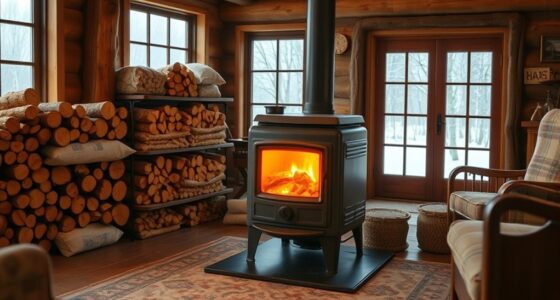Over time, your community’s views on wood smoke and air quality have shifted slowly, often shaped by longstanding cultural traditions and growing awareness of health risks. As more people recognize wood smoke’s links to respiratory and heart issues, perceptions begin to change, especially with the help of monitoring data and health campaigns. This evolving understanding encourages behavioral shifts and policy support. Keep exploring to discover how awareness continues to grow and influence community health efforts.
Key Takeaways
- Public awareness of health risks from wood smoke has increased gradually, especially as scientific evidence and monitoring data become more accessible.
- Traditional views often see wood burning as safe and natural, delaying perception shifts about its health impacts.
- Policy campaigns and air quality data visualization have effectively highlighted pollution dangers, influencing public perception over time.
- Personal or community health issues accelerate recognition of wood smoke’s hazards, prompting behavioral and attitudinal changes.
- Cultural attachment and longstanding practices can slow perception changes, but targeted education and transparent data foster increased concern.

Understanding how the public perceives wood smoke and air quality over time is essential for developing effective policies and awareness campaigns. When it comes to health impacts, many people underestimate the risks associated with wood smoke, often viewing it as a benign or even traditional aspect of rural life. However, scientific research has consistently shown that exposure to wood smoke can lead to serious health issues, including respiratory problems, cardiovascular disease, and exacerbation of asthma. As awareness of these health impacts grows, public perception shifts, but this change can be gradual and uneven. Some communities may recognize the dangers quickly, especially if they or their loved ones experience health problems linked to wood smoke. Others, however, cling to the belief that wood burning is a natural and safe way to heat homes, especially in areas where it’s been a longstanding tradition.
Policy awareness plays an important role in shaping these perceptions. When governments and health organizations actively promote policies aimed at reducing wood smoke emissions, the public begins to connect these efforts with health benefits. Campaigns that highlight the health impacts of wood smoke can effectively raise awareness, but their success depends on clarity, consistency, and cultural relevance. For example, providing data on how fine particulate matter from wood burning worsens health can motivate residents to adopt cleaner heating methods or improve wood stove efficiency. Conversely, if policies are perceived as restrictive or disconnected from local realities, public resistance may grow, hampering efforts to improve air quality. A public understanding of the health risks associated with wood smoke is crucial for fostering support for these policies. Additionally, advancements in air quality monitoring technology can help communities better visualize pollution levels and validate health concerns.
Over time, as policies become more visible and accessible, you might notice a gradual shift in perceptions. People begin to see wood smoke not just as a traditional comfort but as a health hazard that needs regulation. This evolving awareness can lead to behavioral changes, like upgrading to cleaner heating systems or altering burning practices. However, the pace of change hinges on how well policies are communicated and how effectively health impacts are conveyed to the public. In some cases, community engagement and education play pivotal roles, making policy awareness more personal and immediate. When you understand the health impacts and the reasons behind regulations, you’re more likely to support or even advocate for policies that improve air quality. Additionally, increasing public education efforts can accelerate this positive perception shift, ultimately leading to healthier communities. Recognizing the role of scientific research in shaping policies can further reinforce the importance of evidence-based decision-making.
Frequently Asked Questions
How Do Perceptions Vary Across Different Geographic Regions?
You’ll notice that perceptions of wood smoke and air quality vary across regions due to cultural differences. In rural areas, people often see wood burning as traditional and eco-friendly, while urban residents may view it as a pollution source. These regional cultural differences influence attitudes, with urban dwellers typically more concerned about air quality. Understanding these perceptions helps tailor communication strategies for better air quality management.
What Health Impacts Are Most Associated With Wood Smoke?
You’re most likely aware that wood smoke can cause respiratory issues like asthma and bronchitis, making breathing difficult. It also contributes to cardiovascular effects, increasing your risk of heart attacks and strokes. When exposed to wood smoke, your lungs and heart are under stress, especially if you have pre-existing conditions. Reducing exposure helps protect your health by minimizing these harmful respiratory and cardiovascular impacts.
How Have Public Policies Influenced Perceptions Over Time?
Policies shift like tides, shaping public perception over time. Your awareness heightens as policy shifts and awareness campaigns act as lighthouse beams, guiding understanding of wood smoke’s health impacts. Regulations and public messaging have made you more conscious of air quality, turning concern into action. These efforts illuminate the importance of cleaner air, gradually transforming perceptions from dismissive to vigilant, empowering you to advocate for healthier environments.
What Role Does Media Play in Shaping Public Opinion?
Media influence plays a vital role in shaping your opinion by highlighting certain aspects of wood smoke and air quality. However, misinformation effects can distort your understanding, leading you to underestimate or overestimate the risks. When media outlets emphasize sensational stories or omit key facts, it impacts how you perceive air quality issues. Staying critical and seeking reliable sources helps you form a more accurate view, counteracting misinformation effects.
Are There Demographic Factors Affecting Attitudes Toward Air Quality?
Demographic influence markedly shapes your attitude toward air quality, with factors like age, education, and location creating attitudinal differences. Younger individuals may prioritize environmental concerns more than older groups, while urban residents often worry about pollution more than rural residents. Socioeconomic status can also affect perceptions, as those with higher education levels tend to understand pollution risks better. Recognizing these demographic influences helps tailor effective communication and policy efforts.
Conclusion
So, next time you breathe in that cozy, smoky aroma, remember you’re inhaling a delightful blend of nostalgia and pollution. As perceptions shift, maybe someday we’ll all happily cozy up with our fireplaces, blissfully ignoring the hazy, toxic cloud hovering just above. After all, who needs clear air when you can have warm memories? Just keep your nose in the air—and maybe a mask in your pocket—because that charming wood smoke might just be your new favorite aroma.











